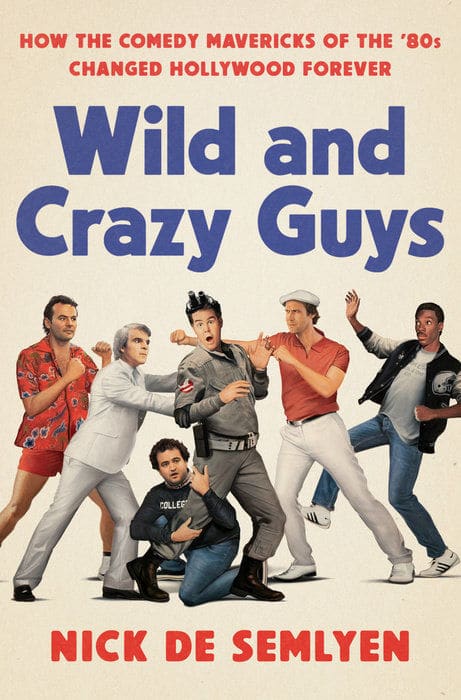“Wild and Crazy Guys: How the Comedy Mavericks of the ’80s Changed Hollywood Forever” (Crown Archetype), by Nick de Semlyen
Our favorite funnymen of the 1980s reached glorious heights and managed to endure the decade despite some appallingly unfunny lows. Sharing “SNL” in their DNA, most of them worked together in front of the camera at some point and, behind the scenes, commiserated at times over the vagaries of show business.
Offering colorful film backstories and insightful portraits of Bill Murray, Steve Martin, Eddie Murphy, Chevy Chase, John Belushi and Dan Aykroyd, author Nick de Semlyen’s “Wild and Crazy Guys” explores the nature of stardom itself — the struggle to be noticed and the even greater struggle to stay noticed. Interestingly, their careers often followed similar trajectories.
One common challenge was surviving all that fame and fortune. Belushi, the “Animal House” and “Blues Brothers” star, couldn’t handle the high of success, morphing from comedic wunderkind to cautionary tale when he died of a drug overdose at 33. Others who dabbled in drugs and alcohol managed to avoid his fate — the late John Candy’s self-destruction was more about food and drink — but they still faced personal and professional stumbling blocks.
Chase’s were less a matter of too much too soon than finding the good material and avoiding the bad. The first star spawned by “Saturday Night Live,” the mother ship of post-Watergate American comedy, Chase enjoyed comparisons to Cary Grant with his star turn in “Foul Play.” Then came “Oh Heavenly Dog” and several other box-office canines. Fortunately, “Caddyshack” and “National Lampoon’s Vacation” put Chase’s best qualities front and center again and led to “Fletch” and “Spies Like Us.”
De Semlyen’s solid reporting and interviewing show how hard work helps but isn’t always enough. Aykroyd comes off as the worker bee, taking leading and supporting roles while constantly dreaming up ideas for movies. His script laying the groundwork for “Ghostbusters” had started out as another vehicle for his friend and co-star Belushi. That megahit, which followed “Trading Places” with Murphy, led to years of reliable comedy work plus an occasional dramatic role, including his Oscar-nominated support in “Driving Miss Daisy.”
For all their wildness and craziness, being taken seriously for a change was a must. Murray and Martin may have tried a little too soon to suit their fans. Buffeted by the intense fandom that came with “Ghostbusters” and the personal disappointment generated by his critically rejected dramatic turn in “The Razor’s Edge,” Murray practically went into hiding for a few years to figure things out.
Martin could relate to the hunger for drama. “The Jerk” was a solid starring debut, but he put off audiences and critics with the oddball musical “Pennies from Heaven” — Fred Astaire hated it — then appeared in a half-dozen comedies that were mildly amusing at best. He mixed laughs with romance for “Roxanne” and laughs with drama for “L.A. Story” before transitioning into family-friendly comedies, a reliable venue for graying mavericks.
If anyone could do no wrong, it seemed to be Murphy. Barely out of his teens when he first appeared on “SNL,” he started off big with “48 Hrs.” and “Trading Places” and soon blew down the doors with “Beverly Hills Cop.” He was the golden child of ’80s comedy until “The Golden Child,” but then the blockbuster “Coming to America” made everything right again. Murphy didn’t risk ruining himself with drugs, preferring women as his not-so-guilty pleasure. And, like Martin and the others, he stayed in the game by playing dads and other middle-age characters.
A flaw in de Semlyen’s enjoyable book is its bent toward fact over analysis. His answer to the question posed by its subtitle — a couple of paragraphs about legacies, rule-breaking and commercial success — feels perfunctory.
Looking back three decades, it’s hard to remember when Murray, Martin, Murphy and Aykroyd weren’t part of the American scene. De Semlyen’s welcome flashback reminds us why their very names still bring a smile to our faces.
___
Douglass K. Daniel is the author of “Anne Bancroft: A Life” (University Press of Kentucky).






